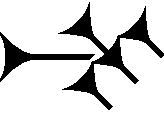
The cuneiform lu sign is a common, multi-use sign, a syllabic for lu, and an alphabetic sign used for l, or u; it has many other sub-uses, as seen in the Epic of Gilgamesh over hundreds of years, and the 1350 BC Amarna letters. Its other uses show other syllabic and alphabetic forms that it can be used for: other vowels, or consonants;. There are also four sumerogrammic sub-forms for "lu" in the Epic of Gilgamesh, LU, and UDU, and DAB and DIB; LU transposes to Akkadian language, "lullû", for English language, (primitive) man; DAB transposes to ṣabātu, English for to seize, capture.

The cuneiform ir, or er sign is a sign used in the Epic of Gilgamesh, and the Amarna letters. It is in a small group that have smaller, 3-verticals, as well as 2- and 1-vertical strokes, sitting on a lower horizontal cuneiform stroke.

The cuneiform dan sign is a multi-use sign found in both the 14th century BC Amarna letters and the Epic of Gilgamesh. Besides dan,, the following are its uses :
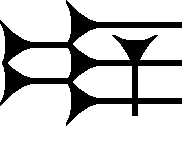
The cuneiform sign for tur is used to denote one syllabic usage, tur, or the sign's Sumerograms; it is used in the Epic of Gilgamesh and the 14th century BC Amarna letters. The sign is based on the i (cuneiform) sign, with the one small added vertical stroke.
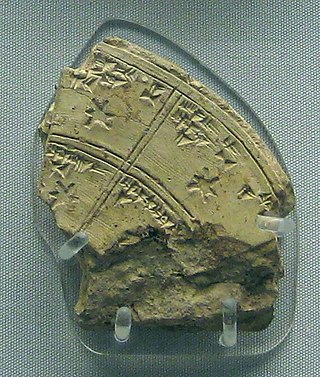
The cuneiform sign 𒀀 for a, and in the Epic of Gilgamesh the sumerogram A, Akkadian for mû, "water", which is used in the Gilgamesh flood myth, Chapter XI of the Epic, or other passages. The sign is also used extensively in the Amarna letters.

The cuneiform pa sign,, has many uses in both the 14th century BC Amarna letters and the Epic of Gilgamesh. It is routinely and commonly used to spell the Akkadian language word "pānu", face, presence, and with a preposition, before. In the photo of the obverse of EA 364, it is used to spell Akkadian "eperu", 'dust', (EA 364, lines 7,8: "...andand \ dust"-.
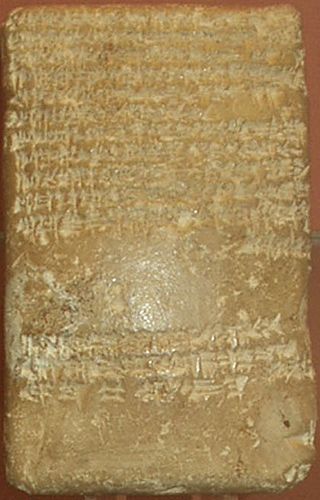
The cuneiform DAGAL sign, which is a capital letter (majuscule) Sumerogram with the Akkadian language meaning of to be wide, or extensive; also "many", Akkadian "rapāšu", is a minor usage cuneiform sign used in the Amarna letters and the Epic of Gilgamesh. An equivalent usage sign for DAGAL is used in the Amarna letters, gáb, for Akkadian language "gabbu", and is found in such letters as EA 362, EA 367, and others. Gáb has other syllabic values, which are used for separate Akkadian word components.

The cuneiform sign (𒀊) for the syllable ab also represents that for ap, or the vowel and consonant usages of a, b, or p: in the Akkadian language "b" is unaspirated, formed with the lips, and "p" is aspirated, with the breath). In the Akkadian language "b" and "p" are interchangeable; also, in cuneiform texts, any vowel can be interchanged with any other. The ab/ap sign also has a corresponding capital letter (majuscule) usage as a sumerogram, as found in the Epic of Gilgamesh for AB, the Akkadian language for šību, meaning "elder".

Cuneiform sign nu is a common use syllabic, or alphabetic. It is restricted to "nu", but in the Epic of Gilgamesh, or elsewhere has a Sumerogram use NU, and probably mostly for a component in personal names (PN), god's names, or specialized names for specific items that use Sumerograms.

The cuneiform ha sign comes in two common varieties in the 1350 BC Amarna letters. It is also found in the large 12-chapter (Tablets I-XII) work of the Epic of Gilgamesh. Cuneiform ha is used as a syllabic for ha, and an alphabetic for h, or a; from the Epic of Gilgamesh it also has two sumerogramic uses (capital letter (majuscule)), for HA (Akkadian language zittu, for "share"), and KU6, for nūnu, "fish".

The cuneiform bad, bat, be, etc. sign is a common multi-use sign in the mid 14th-century BC Amarna letters, and the Epic of Gilgamesh. In the Epic it also has 5 sumerogram uses. From Giorgio Buccellati 'comparative graphemic analysis', of 5 categories of letters, the usage numbers of the bad sign are as follows: Old Babylonian Royal letters (71), OB non-Royal letters (392), Mari letters (2108), Amarna letters (334), Ugarit letters (39).

The cuneiform sign tu, and for TU-(the Sumerogram, capital letter, in the Hittite language and other cuneiform texts, is a common-use syllabic sign for tu, and also with a syllabic use for "t", or "u". It is not a multi-use sign, with other alphabetic sub-varieties.
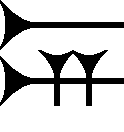
The cuneiform sign ni is a common-use sign of the Amarna letters, the Epic of Gilgamesh, and other cuneiform texts. It has a secondary sub-use in the Amarna letters for addressing the Pharaoh, from the vassal states of Canaan. The address to the Pharaoh is often 'King-Lord-Mine': LUGAL, EN-ia which has many varieties of expression. "LUGAL” is the Sumerian name for the cuneiform glyph read in the Akkadian language as "Šarru", translating as English "king", and EN is read in Akkadian as bēlu, for "Lord",. In some Amarna letters the sub-use of ni is lí, for spelling "bēlu", be-lí often .

The cuneiform di sign, also de, ṭe, ṭi, and sumerograms DI and SÁ is a common-use sign of the Epic of Gilgamesh, the 1350 BC Amarna letters, and other cuneiform texts. In the Akkadian language for forming words, it can be used syllabically for: de, di, ṭe, and ṭi; also alphabetically for letters d, ṭ, e, or i. Some consonant-pairs (d/t), are also interchangeable.
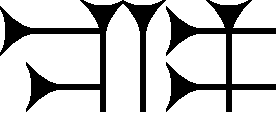
The cuneiform ta sign is a common, multi-use sign of the Epic of Gilgamesh, the 1350 BC Amarna letters, and other cuneiform texts. It also has a sumerogrammic usage for TA, for example in the Epic of Gilgamesh, for Akkadian language "ultu", English language for from, or since, but in only (1) location in the 12 tablet Epic of Gilgamesh. Sumerogram TA is used elsewhere in the Epic, (7) more times.

The cuneiform sign ba, is a common-use sign of the Amarna letters, the Epic of Gilgamesh, and other cuneiform texts.
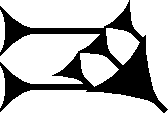
The cuneiform sign am, is a common-use sign of the Amarna letters, the Epic of Gilgamesh, and other cuneiform texts. It is also used as AM.

The cuneiform kur sign,, has many uses in both the 14th century BC Amarna letters and the Epic of Gilgamesh. It is routinely and commonly used to spell the Akkadian language word "mātu", for "land", "country"; also possibly "region". In EA 288, a letter from the Abdi-Heba, the Governor of Jerusalem, the kur sign is used eight times.

The cuneiform sign at, is a common-use sign of the Amarna letters, the Epic of Gilgamesh, and other cuneiform texts. It has secondary uses in the Amarna letters for "ad".

The cuneiform sign hal, is a common-use sign in the Epic of Gilgamesh, the Amarna letters, and other cuneiform texts, for example Hittite texts. Its common usage is syllabic for hal, but could also be use for alphabetic h or l, or the a, and for the other three vowels of e, i, or u.
